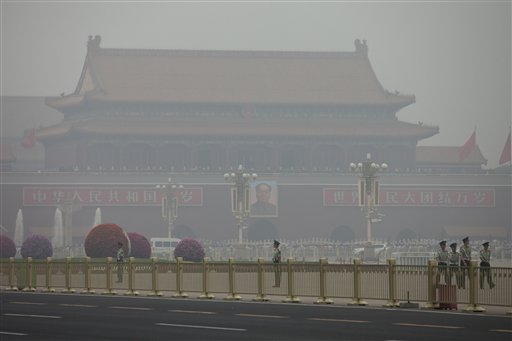By LOUISE WATT
Associated Press
BEIJING
China’s Cabinet has announced measures to curb the country’s notorious air pollution, one of the many environmental challenges facing the country that are increasingly angering the public.
The broad measures approved by the State Council include putting strict controls in place for industries that produce large amounts of waste and pollution, but it will likely be up to local governments to work out the details.
In a meeting chaired by Premier Li Keqiang, the State Council approved 10 “tough measures to accomplish tough tasks,” the council said in a statement on its website late Friday.
These include a target to reduce pollution emissions by at least 30 percent in heavy-polluting industries by the end of 2017 _ a target that is more ambitious than any in the past. Heavily polluting industries do already have emissions standards but they are not necessarily enforced and critics say they aren’t stringent enough anyway.
China’s growing middle class has become increasingly fed up with air, water and soil pollution that has resulted from development-at-all costs policies. Members of the public have virtually no say on industrial projects, and often protest against factories or petrochemical plants they fear could affect their health.
In February, the environment ministry announced six heavily polluting industries, including iron, steel, petrochemicals and cement, would have to gradually comply with “special” emissions standards, but details were unclear.
In its announcement of the new measures, the State Council said local governments should shoulder the general responsibilities for local air quality.
During periods of heavy pollution, the local governments should enact emergency response measures, such as restricting traffic or enacting emissions limits for polluting industries, it said.
Strict controls will be put in place for industries that produce large amounts of waste and pollution and hope to expand, while efforts to eliminate outdated technology in the steel and cement industries, among others, will be strengthened, it said. Construction projects that fail to pass environmental evaluations should not receive permission to go ahead.
China’s new measures are intended to adjust the country’s energy structure, increase supplies of cleaner-burning fuels such as natural gas and methane, raise the quality of car fuel and phase out older, more polluting, cars.
Some cities including Beijing already have raised their car fuel standards, but there has been no national approach.
The Cabinet also expressed support for the country’s solar industry during its “production and operating difficulties.” It is wrestling with overcapacity and, earlier this month, the European Union hit Chinese exporters of solar panels with anti-dumping duties. The United States did the same thing last year.
On Saturday, pollution hung over Beijing’s central business district, blocking out much of the blue sky.
While burning of coal for power plants is a major source of air pollution across China, vehicle emissions are a big source of tiny particulate matter known as PM2.5 in dense cities. In January, the air pollution in Beijing garnered unprecedented coverage by state media when PM2.5, which can enter deep into the lungs, went beyond 700 micrograms per cubic meter. The World Health Organization considers a safe level to be 25 micrograms per cubic meter.
A Deutsche Bank report on air pollution in China released earlier this month called for significant policy changes to reduce the urban PM2.5 to a level of 30 by 2030. It said China should sharply reduce the growth in coal consumption and new cars and massively increase investment in cleaner energies _ gas, nuclear, hydroelectric, wind and solar _ and in subways and railways.
The measures approved by the state council talk about strengthening international cooperation in fostering a “new energy industry” but do not specifically mention solar, wind, hydroelectric or nuclear energy.
Environmental campaigner Ma Jun said the measures show the central government is continuing to pay great attention to air pollution, “one of the major concerns of the public.”
However, local governments pose a potential obstacle because they understand that their performance is judged by growth, said Ma, director of the Institute of Public and Environmental Affairs. “When it comes to the approval of new projects, the local governments often still pursue the highly energy- and pollution-intensive projects which can often generate higher GDP growth rate in the short term,” he said.
One measure says heavily polluting industries and companies will be required to publicize information about how their operations affect the environment. When such information is disclosed to the public, it will be harder for local governments to interfere, Ma said.
___
AP researcher Henry Hou contributed to this report.

COMMENTS
Please let us know if you're having issues with commenting.